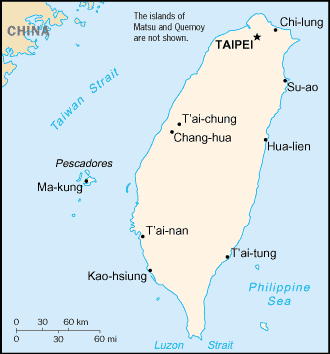Map:

Overview:
In 1895, military defeat forced China to cede Taiwan to Japan. Taiwan reverted to Chinese control after World War II. Following the Communist victory on the mainland in 1949, 2 million Nationalists fled to Taiwan and established a government using the 1946 constitution drawn up for all of China. Over the next five decades, the ruling authorities gradually democratized and incorporated the native population within the governing structure. In 2000, Taiwan underwent its first peaceful transfer of power from the Nationalist to the Democratic Progressive Party. Throughout this period, the island prospered and became one of East Asia's economic "Tigers." The dominant political issues continue to be the relationship between Taiwan and China - specifically the question of eventual unification - as well as domestic political and economic reform.
The People:
Population: 22,894,384 (July 2005 est.)
Age structure:
0-14 years: 19.7% (male 2,349,077/female 2,156,755)
15-64 years: 70.7% (male 8,205,933/female 7,980,056)
65 years and over: 9.6% (male 1,107,708/female 1,094,855) (2005 est.)
Religions:
mixture of Buddhist, Confucian, and Taoist 93%, Christian 4.5%, other 2.5%
Government Type:
multiparty democratic regime headed by popularly-elected president and unicameral legislature
Leader(s) to pray for:
chief of state: President CHEN Shui-bian (since 20 May 2000) and Vice President Annette LU (LU Hsiu-lien) (since 20 May 2000)
head of government: Premier (President of the Executive Yuan) Frank HSIEH (since 1 February 2005) and Vice Premier (Vice President of the Executive Yuan) - WU Rong-i) (since 18 February 2005)
Source: The World Factbook
View All Countries